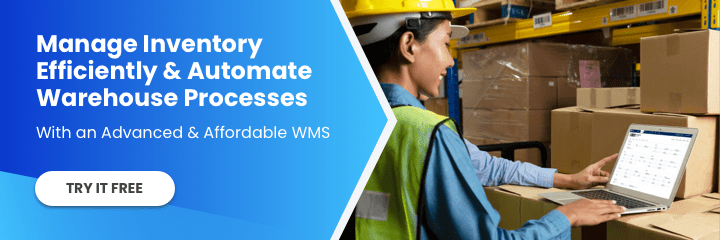[ad_1]
The six fundamental warehouse processes comprise receiving, putaway, storage, picking, packing, and shipping. Optimizing these six processes will allow you to streamline your warehouse operation, reduce cost & errors, and achieve a higher perfect order rate.
In this article, we will discuss each warehouse process in order to understand and effectively optimize your operations. After each process is explained, general recommendations to optimize each one will be discussed, and in-depth optimization resources will be linked for your convenience.
Almost all quality improvement comes via simplification of design, layout, processes, and procedures.
Tom Peters
1. Receiving
Receiving is the first warehouse process and one of the most crucial. To perform the receiving process properly, the warehouse should be able to verify that it has received the right product, in the right quantity, in the right condition, and at the right time. Failing to do so will have consequent impacts on all subsequent operations
Receiving also involves the transfer of responsibility for the goods to the warehouse. This places accountability on the warehouse for maintaining the condition of the goods until they are shipped. Properly receiving cargo will allow you to filter out damaged goods and avoid liability for them.
How to Optimize:
The aim of optimizing the warehouse receiving process is to receive cargo efficiently and correctly and to avoid accumulation at the receiving docks. Solutions such as power pallet trucks and conveyors will allow you to unload cargo and clear dock areas faster and more efficiently. In addition, parcel and pallet dimensioning systems can automate the capture of the weight and dimensions of parcels and pallets to accelerate your receiving processing and obtain certified measurements. Finally, software such as labor management systems and dock schedulers allow you to properly allocate the right amount of personnel by accurately anticipating upcoming shipments.
To learn more warehouse receiving best practices, you can read our article here.
You can also watch our video here: https://youtu.be/zsNpQ5huPdI
2. Put-Away
Put-away is the second warehouse process and is the movement of goods from the receiving dock to the most optimal warehouse storage location. Failing to place goods in their most ideal location can impair the productivity of warehouse operation. When goods are put away properly, there are several benefits:
-
Cargo is stored faster and more efficiently
-
Travel time is minimized
-
Safety of goods and employees is ensured
-
Warehouse space utilization is maximized
-
Cargo is easier and faster to find, track, and retrieve
How to Optimize:
The aim of optimizing the putaway process is to move goods for storage to their most optimal location in a fast, efficient, and effective manner. Software such as slotting and space management systems automatically assign optimal spaces for each cargo to allow for a streamlined putaway process and maximized space utilization. In addition, putaway mobile applications and devices direct clerks to store cargo in the right location.
To learn more warehouse putaway best practices, you can read our article here.
3. Storage
Storage is the warehouse process in which goods are placed into their most appropriate storage space. When done properly, the storage process fully maximizes the available space in your warehouse and increases labor efficiency.
How to Optimize:
Optimizing your storage process is only possible when the right KPIs are properly tracked. Having a software that automatically calculates your warehouse storage utilization and tracks the right storage KPIs will allow you to determine how efficient each aspect of your storage process is. Slotting optimization systems can also help you by assisting with the allocation of the best storage location for a given cargo. Lastly, utilizing the right warehouse storage system according to the size of your facility and product mix allows you to maximize your horizontal and vertical spaces while improving warehouse efficiency.
To learn more about warehouse storage best practices, you can read our article here.
_result.jpg?width=688&height=450&name=shutterstock_541183837%20(1)_result.jpg)
4. Picking
Picking is the warehouse process that collects products in a warehouse to fulfill customer orders. Since it is the costliest process in the warehouse, comprising as much as 55% of the total operating expense, optimizing this process will allow you to reduce costs significantly and increase your warehouse efficiency. Streamlining of this process should also focus on achieving higher accuracy, as errors can have a direct impact on your customer satisfaction.
How to Optimize:
One of the ways to optimize the picking process is introducing the right technologies. Technologies such as mobile and wearables can streamline the picking process because they allow clerks to view picking lists wirelessly, access systems in real time, and scan anywhere in the warehouse. Other viable options include conducting an ABC analysis to improve your warehouse layout, selecting the right picking methodology, and utilizing software to guide clerks in properly executing the picking process.
To learn more warehouse picking best practices, you can read our article here.
Also, here is a short video to learn how mobile and wearables can impact your picking process: https://youtu.be/s6LI-oh7RbY
5. Packing
Packing is the warehouse process that consolidates picked items in a sales order and prepares them for shipment to the customer. One of the primary tasks of packing is to ensure that damages are minimized from the time items leave the warehouse. Additionally, packaging must be light enough so as not to increase the weight of the goods and minimal enough to control packaging costs.
How to Optimize:
Optimizing the packing process can be done by utilizing software to guide people in executing the tasks. Provided that a packing system has all the necessary data, such as dimensions and weight, the system can automatically determine the type and amount of packaging material that will keep the item safe and packing costs low.
To learn more warehouse packing best practices, read this article here.
6. Shipping
Shipping is the final warehouse process and the start of the journey of goods from the warehouse to the customer. Shipping is considered successful only if the right order is sorted and loaded, is dispatched to the right customer, travels through the right transit mode, and is delivered safely and on time.
Previous processes, such as ordering, putaway, picking, and packing, are also vital to the success of shipping because they greatly affect whether the order is fulfilled accurately and safely.
How to Optimize:
To optimize the shipping process, having software systems to streamline many of the tasks is critical. Labor management systems let you allocate the right amount of resources to prevent over or under allocation. Having a shipping mobile application and device lets you have the right information on hand and in real time to verify shipments on the fly. And loading systems can let you have guides that clearly instruct how to load cargo safely and efficiently.
To learn more warehouse shipping best practices, you can read our article here.

The warehouse industry is growing in response to developments such as the rise of e-commerce, globalization, and the trend of outsourcing warehouse services. These major changes in the market are opportunities waiting for you to exploit by taking swift actions to optimize your warehouse processes. Hopefully, this article has helped you understand the objective of each process and helped in providing tips for optimization.
Check out the top warehouse KPIs to track the performance of the above-mentioned warehouse processes.
If you are ready to find the solution to optimize any of the above-mentioned warehouse processes, go to our Solutions Finder tool.
If you want more warehouse content or are curious about “Warehouse Digitalization,” you can follow us on LinkedIn, YouTube, Twitter or Facebook. You can also message us through our contact page if you have other inquiries. We’ll be very glad to help.
[ad_2]
Source link















